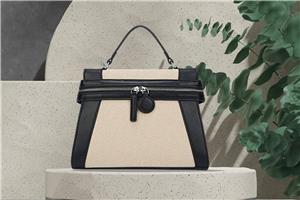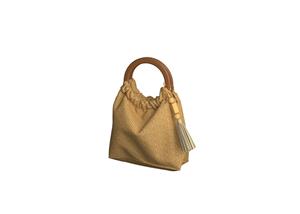I 10 migliori materiali per borse di paglia
: Il giacinto d'acqua viene solitamente presentato nei toni della terra.
5.IutaPanoramicaDescrizione e origineLa iuta proviene dal gambo e dalla pelle esterna della pianta di iuta, coltivata principalmente in India e Bangladesh. Gli agricoltori raccolgono le piante, le immergono nell'acqua e poi spogliano le fibre. Queste fibre sono lunghe, morbide e lucenti, il che le rende ideali per la tessitura.
Usi comuni nei sacchi di paglia
La iuta appare spesso
borse della spesa
,
borse da spiaggia
e borse del mercato. Gli artigiani tessono le fibre di iuta in modelli robusti e durevoli. Molti designer apprezzano la iuta per il suo fascino rustico e la sua natura ecologica.
Pro e contro
?????
????? ??????: ????? ???? ?????? ???????.
?????: ????? ??????? ???? ???? ???? ?? ????? ????????? ??????.
?????? ???????: ???? ?????? ?????? ??????? ?????? ??????.
??? ????: ????? ????? ???? ????? ????????.
??????
?????? ?????: ???? ?? ???? ????? ??? ????? ???????.
?????: ???? ???? ??? ????? ?????? ?????? ??? ???? ???????.
?????? ????? ??????: ????? ???? ???? ?????? ??????.
6. ????????
????
????? ??????
???????? ?? ??? ???? ????? ???? ?? ????? ?????? ?? ??????? ??? ?? ??? ???? ???????? ??????? ????????. ???? ???????? ???? ????? ???????? ?? ???????? ??? ????? ?????. ???? ??? ??????? ?????? ?????? ??????? ????????. ????????
????? ????????
??????? ?????? ?????? ???? ?????? ?????? ???????.??????????? ??????? ?? ????? ?????????? ?? ???? ???????? ?? ????? ???? ?????? ?????? ?????? ????. ???? ???????? ???? ????? ???????? ?? ????? ?????? ??? ???? ??????? ????? ??????. ???? ???????? ???????? ??????? ??????? ???? ???????? ?? ????????? ?? ?????????? ????? ??????????????? ????????. ???? ????? ???????? ?????? ????? ?? ??????? ??? ??????? ?????????? ???????.
???????? ???????
?????
????? ??????: ???????? ???? ??????? ?????? ?????? ?????????.
?????: ????? ???????? ???? ????? ?? ????? ????????? ??????.
?????? ???????: ???? ?????? ?????? ??????? ?????? ?????? ???????.
??? ????: ????? ???????? ???? ????? ????????.
?????
: ???? ??? ???????? ?????? ?????? ??????.??????
?????? ?????: ???? ?? ???? ???????? ??? ????? ???????.
?????: ???? ???? ??? ????? ?????? ?????? ??? ???? ???????.
?????? ????? ??????
: ???? ???????? ????? ?????? ??????.
7. ??? ??????
????
????? ??????
???? ????? ?????? ?? ????? ?????? ?? ????? ?????? ???????? ?? ??????? ??????????. ???? ???????? ??????? ????????? ?????? ????? ????. ??? ??????? ??? ??????? ???? ???? ?? ????? ????????? ???????.
??????????? ??????? ?? ????? ????
?????? ?? ??????? ????? ?????? ?? ????? ?????? ?????? ???? ????????. ???? ???????? ???? ??????? ?? ????? ?????? ??? ???? ????? ???????? ?????. ???? ?????? ?? ???????? ?????? ??????? ????? ????? ??????.
???????? ????????????
????? ??????: ????? ?????? ????? ?????? ????????.
?????: ???? ?????? ?????? ???????? ???? ???? ?? ????? ????????? ??????.
?????? ???????: ???? ?????? ?????? ??????? ?????? ??????.
??? ????
: ????? ??? ?????? ???? ????? ????????.??????
?????? ?????: ???? ?? ???? ????? ?????? ??? ?????? ???????.
?????: ???? ???? ??? ????? ?????? ?????? ??? ???? ???????.
?????? ????? ??????
: ????? ?????? ???? ?? ???? ?????? ??????.
8. ??? ?????
????
????? ??????
??? ????? ???? ?? ?????? ??????? ????? ?????. ???? ????????? ??? ?????? ??? ???? ?????. ????? ??????? ????? ?????? ???????? ??????. ??? ?? ??????? ??? ?????? ??????? ?? ????? ???????? ??????? ????????.
??????????? ??????? ?? ????? ????
?????? ?? ???? ??? ????? ?? ????? ???? ?????? ?????? ?????? ????. ???? ???????? ???? ?????? ????
????? ?????? ??? ???? ????? ?? ?????. ???? ?????? ?? ???????? ??? ????? ??????? ??????? ?????? ????? ??????.
???????? ????????????
????? ??????: ??? ????? ???? ?????? ???????.
?????: ??? ????? ??????? ???? ???? ???? ?? ????? ????????? ??????.
?????? ???????
: ???? ?????? ?????? ??????? ?????? ??????.Leggero
: I sacchetti di buccia di mais sono facili da trasportare e imballare.: Regular care is needed to maintain the bag's appearance.
Limited Color Options: Water hyacinth usually comes in earthy tones.
5.Jute
Overview
Description and origin
Jute comes from the stem and outer skin of the jute plant, primarily grown in India and Bangladesh. Farmers harvest the plants, soak them in water, and then strip the fibers. These fibers are long, soft, and shiny, making them ideal for weaving.
Common uses in straw bags
Jute often appears in tote bags, beach bags, and market bags. Artisans weave jute fibers into sturdy and durable patterns. Many designers appreciate jute for its rustic charm and eco-friendly nature.
Pros and Cons
Advantages
Eco-Friendly: Jute is biodegradable and sustainable.
Durability: Properly treated jute can withstand daily use.
Aesthetic Appeal: The natural texture and color offer a unique look.
Lightweight: Jute bags are easy to carry and pack.
Disadvantages
Water Sensitivity: Jute can weaken when exposed to moisture.
Maintenance: Regular care is needed to maintain the bag's appearance.
Limited Color Options: Jute usually comes in earthy tones.
6.Bamboo
Overview
Description and origin
Bamboo is a fast-growing grass found in various parts of the world, including Asia, Africa, and South America. Harvesters cut the bamboo stalks and then process them into thin strips. These strips undergo treatment to enhance their flexibility and durability. Bamboo's natural strength and unique texture make it an excellent material for crafting bags.
Common uses in straw bags
Bamboo often appears in tote bags, beach bags, and clutches. Artisans weave bamboo strips into intricate patterns, creating visually appealing designs. High-end fashion brands incorporate bamboo into their collections for its eco-friendly properties and aesthetic appeal. Bamboo bags are popular for both casual outings and formal events.
Pros and Cons
Advantages
Eco-Friendly: Bamboo is a sustainable and biodegradable material.
Durability: Bamboo fibers are strong and can withstand daily use.
Aesthetic Appeal: The natural texture and color offer a unique and elegant look.
Lightweight: Bamboo bags are easy to carry and pack.
Versatility: Bamboo can be woven into various shapes and styles.
Disadvantages
Water Sensitivity: Bamboo can weaken when exposed to moisture.
Maintenance: Regular care is needed to maintain the bag's appearance.
Limited Color Options: Bamboo usually comes in natural tones.
7.Palm Leaves
Overview
Description and origin
Palm leaves come from various species of palm trees found in tropical regions. Harvesters collect the leaves and dry them to create flexible fibers. These fibers have been used for centuries in traditional crafts and weaving.
Common uses in straw bags
Palm leaves are often used in beach bags, tote bags, and clutches. Artisans weave the leaves into intricate patterns, creating unique textures and designs. Many designers appreciate the natural beauty and versatility of palm leaves.
Pros and Cons
Advantages
Eco-Friendly: Palm leaves are biodegradable and sustainable.
Durability: Properly treated palm leaves can withstand daily use.
Aesthetic Appeal: The natural texture and color offer a unique look.
Lightweight: Palm leaf bags are easy to carry and pack.
Disadvantages
Water Sensitivity: Palm leaves can weaken when exposed to moisture.
Maintenance: Regular care is needed to maintain the bag's appearance.
Limited Color Options: Palm leaves usually come in natural tones.
8.Corn Husk
Overview
Description and origin
Corn husk comes from the outer covering of corn ears. Farmers collect these husks after harvesting the corn. The process involves drying and preparing the husks for weaving. This material has been used traditionally in various cultures for crafting and decoration.
Common uses in straw bags
Corn husk often appears in tote bags, beach bags, and clutches. Artisans weave the husks into intricate patterns, creating unique textures. Many designers appreciate corn husk for its eco-friendly properties and rustic charm.
Pros and Cons
Advantages
Eco-Friendly: Corn husk is biodegradable and sustainable.
Durability: Properly treated corn husk can withstand daily use.
Aesthetic Appeal: The natural texture and color offer a unique look.
Lightweight: Corn husk bags are easy to carry and pack.
Versatility: Corn husk can be woven into various shapes and styles.
Disadvantages
Water Sensitivity: Corn husk can weaken when exposed to moisture.
Maintenance: Regular care is needed to maintain the bag's appearance.
Limited Color Options: Corn husk usually comes in natural tones.
9.Paper Straw
Overview
Description and origin
Paper straw comes from tightly woven paper fibers. Manufacturers process these fibers to create a durable and flexible material. This eco-friendly alternative to traditional materials like leather or plastic has gained popularity in recent years. The production process involves recycling paper, making it a sustainable choice for environmentally conscious consumers.
Common uses in straw bags
Paper straw often appears in tote bags, beach bags, and clutches. Artisans weave the paper fibers into intricate patterns, creating unique textures and designs. Many designers appreciate the versatility and affordability of paper straw. High-end fashion brands and local artisans alike incorporate paper straw into their collections.
Pros and Cons
Advantages
Eco-Friendly: Paper straw is biodegradable, recyclable, and renewable.
Durability: Tightly woven paper fibers offer strength and resilience.
Lightweight: Paper straw bags are easy to carry and pack.
Versatility: The material can be woven into various shapes and styles.
Affordability: Paper straw provides a cost-effective alternative to other materials.
Easy Maintenance: Cleaning and maintaining paper straw bags is simple.
Disadvantages
Water Sensitivity: Paper straw can weaken when exposed to moisture.
Limited Color Options: Natural paper straw usually comes in neutral tones.
Potential Wear and Tear: Over time, the fibers may show signs of wear.
10.Synthetic Straw
Overview
Description and origin
Synthetic straw, also known as faux straw, is a man-made material designed to mimic the appearance and texture of natural straw. Manufacturers create synthetic straw using various plastics, including polypropylene and polyethylene. These materials undergo a process of extrusion and weaving to form durable and flexible fibers. Synthetic straw offers a versatile and cost-effective alternative to natural materials.
Common uses in straw bags
Synthetic straw often appears in tote bags, beach bags, and clutches. Designers favor synthetic straw for its ability to hold vibrant colors and intricate patterns. High-end fashion brands and local artisans incorporate synthetic straw into their collections for its durability and aesthetic appeal. The material's resistance to moisture makes it ideal for bags intended for outdoor use.
Pros and Cons
Advantages
Durability: Synthetic straw can withstand daily wear and tear without losing its shape or color.
Water Resistance: Unlike natural straw, synthetic straw remains unaffected by moisture, making it suitable for various weather conditions.
Versatility: The material can be dyed in a wide range of colors and woven into complex patterns.
Low Maintenance: Synthetic straw bags require minimal care to maintain their appearance.
Affordability: Synthetic straw provides a budget-friendly option compared to natural materials.
Disadvantages
Environmental Impact: Synthetic straw is not biodegradable and contributes to plastic pollution.
Aesthetic Limitations: Some consumers may prefer the natural look and feel of traditional straw materials.
Heat Sensitivity: High temperatures can cause synthetic straw to warp or melt, limiting its use in extreme conditions.
Product Information:
Plastic Straw Bag: Made from recycled materials, offering a moldable shape and comfortable belted handles.
Paper Straw Handle Bags: Sustainable and eco-friendly, providing durability and versatility for various designs.
Synthetic straw offers a practical and stylish alternative to natural straw materials. Its advantages in durability, water resistance, and versatility make it a popular choice for many consumers. However, the environmental impact and aesthetic limitations should be considered when selecting a material for straw bags.
Choosing the right material for straw bags ensures durability and style. Each material offers unique benefits:
Natural Straw: Eco-friendly and lightweight.
Raffia: Durable and versatile.
Seagrass: Flexible and rustic.
Water Hyacinth: Sustainable and charming.
Jute: Sturdy and natural.
Bamboo: Strong and elegant.
Palm Leaves: Versatile and beautiful.
Corn Husk: Eco-friendly and unique.
Paper Straw: Affordable and recyclable.
Synthetic Straw: Durable and water-resistant.
Consider personal needs and preferences when selecting a material. Explore different options to find the perfect straw bag.




